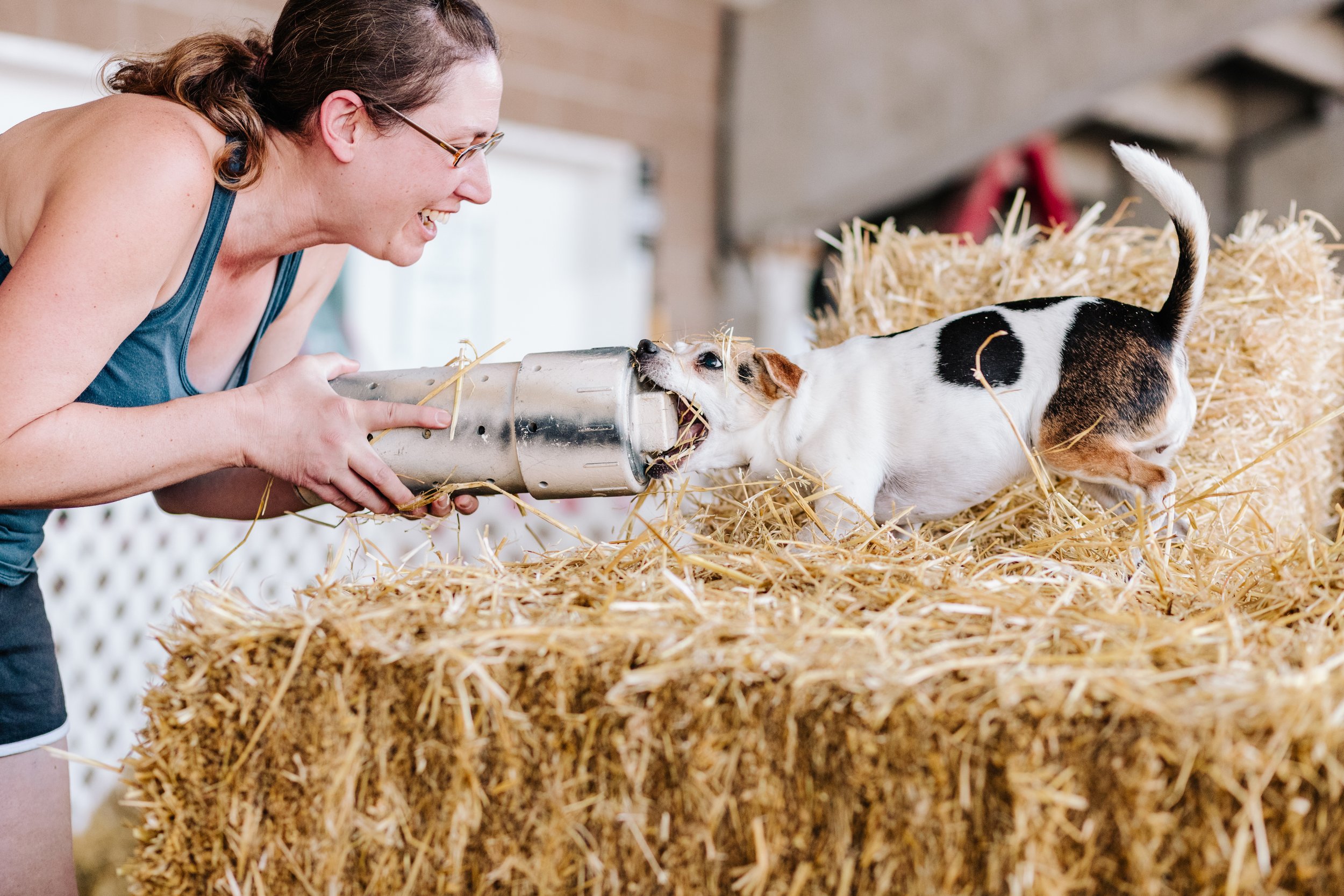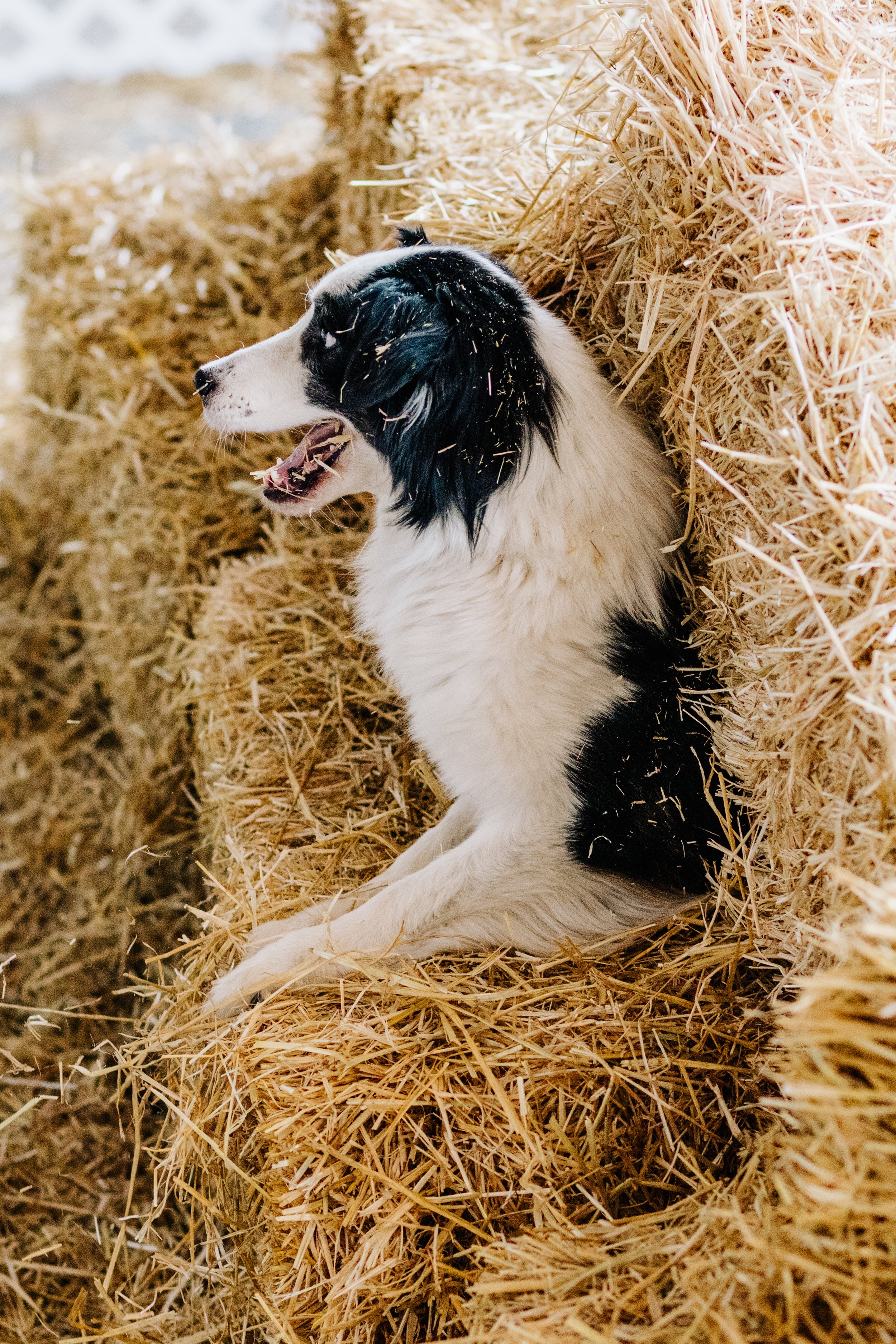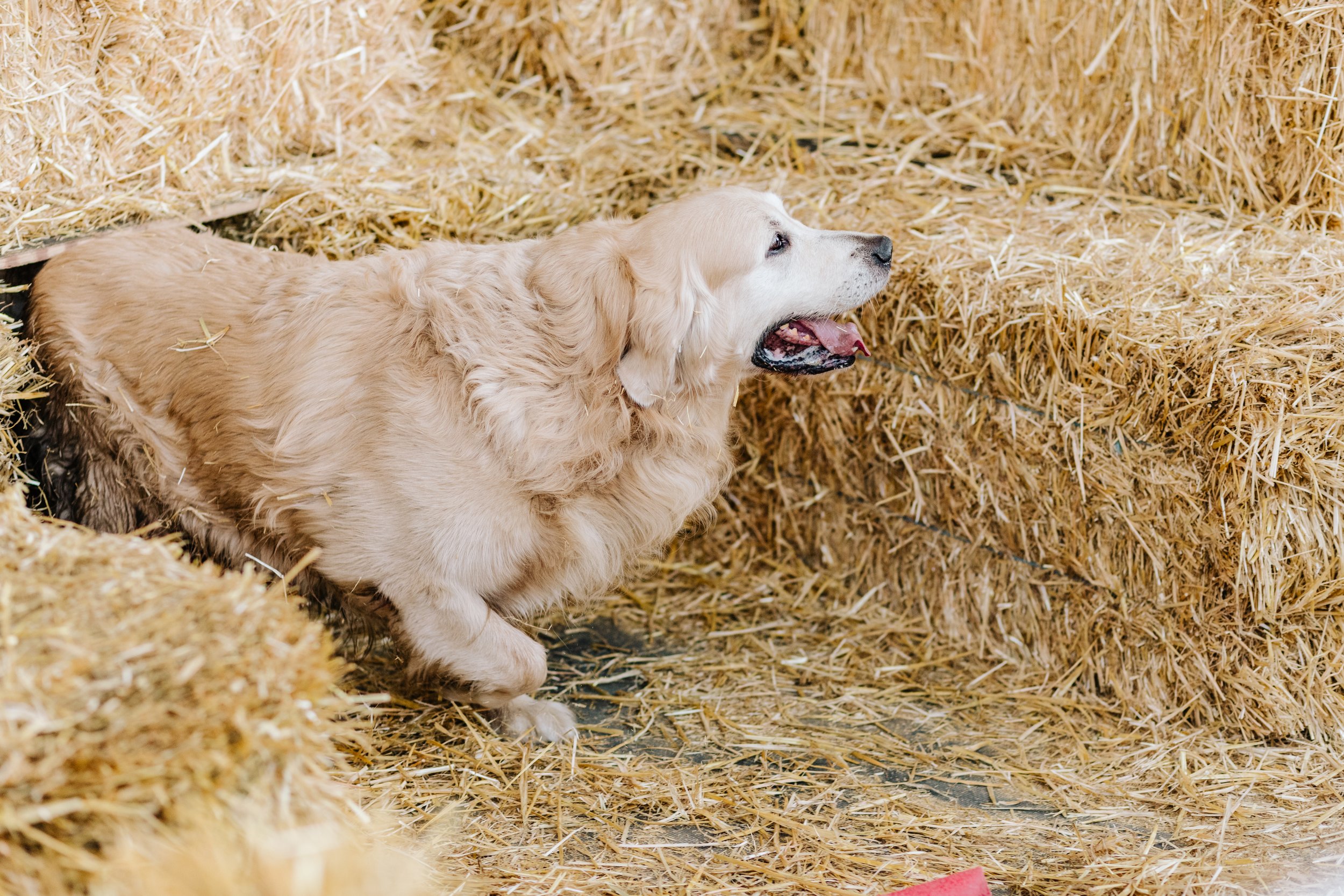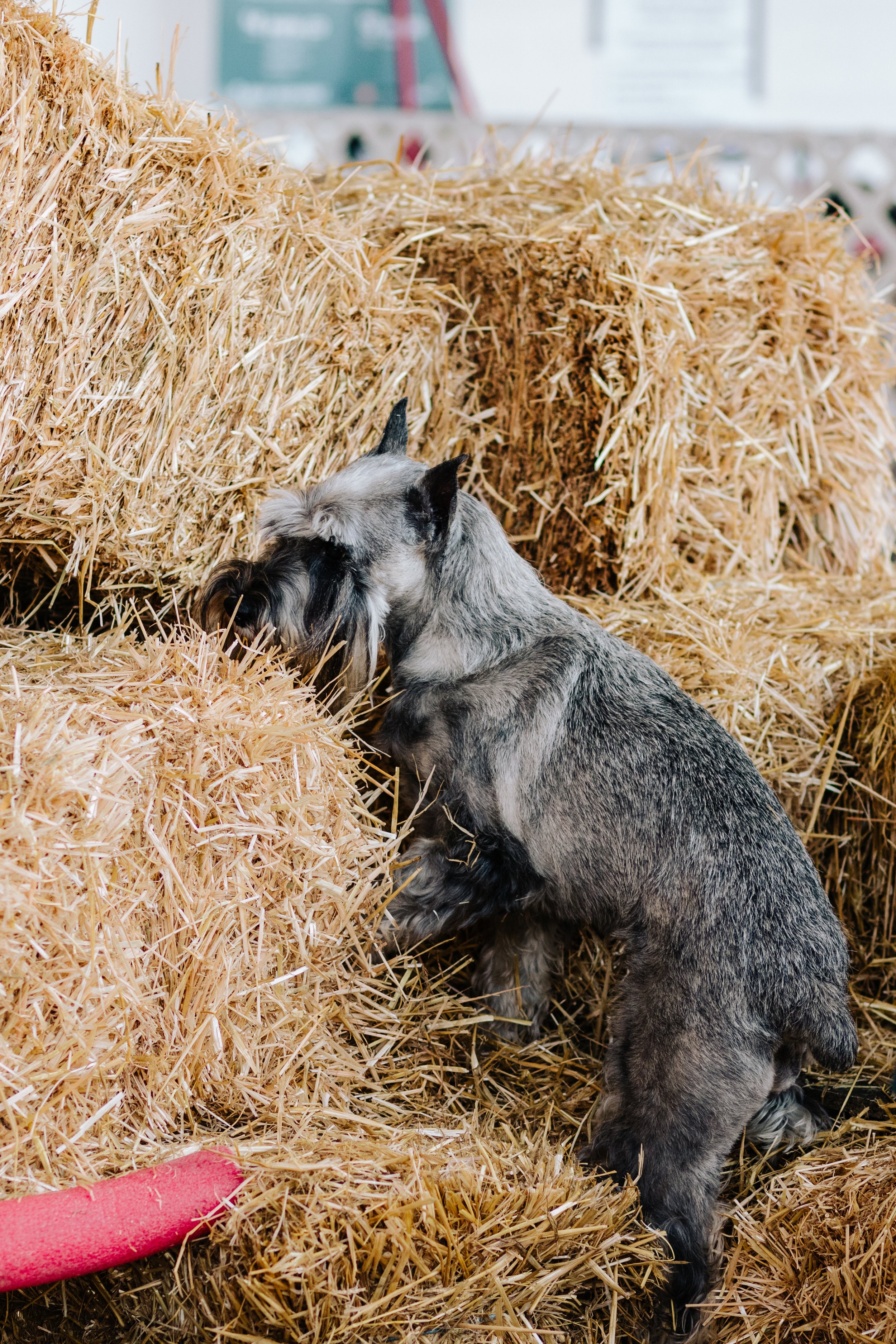Dog Sports for Beginners: Barn Hunt
This post contains affiliate links. If you shop using my affiliate links, I will earn a small commission at no additional cost to you. Thank you for supporting my content!
Dog sports are such an amazing way to bond with your dog! These sports are like games for you and your dog and they allow dogs to harness their natural instincts and senses. You and your dog work as a team, which is great for your relationship and communication.
Starsky and Ginsburg earned their RATN titles the same day!
My favorite dog sports for beginners are Fast CAT and Barn Hunt. There’s little to no barriers to entry for these sports and they are pretty popular so it’s not too difficult to find a Fast CAT event or a barn hunt trainer to start lessons with.
What is Barn Hunt?
Barn Hunt is an exciting and enriching dog sport! The main goal of the sport is for dogs to sniff out rats hidden in bales of straw. The rats are safely enclosed in PVC tubes with ventilation, so it’s perfectly safe for them too. In fact, many rats enjoy the game and even interact with the dogs!
Barn Hunt is a timed sport, so each level has a time limit in which the dog must complete the course.
Barn Hunt also requires two physical obstacles: your dog must go through a tunnel, the length of which depends on the level your dog is competing in, and they must climb up on a bale of straw such that all four of their feet are elevated. Or three feet – tripod dogs who have lost a leg are still eligible to participate!
History of Barn Hunt
Barn Hunt grew out of the American Kennel Club (AKC) dog sport Earthdog. Earthdog is a similar sport that requires dogs to “hunt” rats, but is restricted to certain breeds.
Robin Nuttall, the creator of Barn Hunt, had hoped to try Earthdog, but her dog’s breed was not allowed to participate. Robin sought to open up Earthdog to additional breeds, but ran into roadblocks.
Eventually, Robin developed a new sport, designed to be inclusive of all breeds and mixed breeds.
Barn Hunt’s popularity exploded! It is now known as a “gateway sport” because it doesn’t require much knowledge about dogs or dog competition to get started, and most dogs enjoy it and pick up on the game quickly. Doing Barn Hunt often leads dog owners to try out even more dog sports!
The Barn Hunt Association is an independent dog sports organization, but Barn Hunt titles are recognized by the American Kennel Club, United Kennel Club, and Canadian Kennel Club. In the AKC (and I would assume the others), this means that you can have your Barn Hunt title added to your dog’s registered name for an additional fee.
The Basics of Barn Hunt
The main objective of Barn Hunt is for your dog to locate a number of rats located in PVC tubes. There will also be a certain number of litter tubes with used rat bedding, but no rat, in them. The number of rats, litter, and empty tubes varies with the level.
The tubes are hidden within an obstacle course made of bales of straw. Your dog will also have to go through a tunnel made of straw, the length of which depends on the level. Finally, your dog must “climb” a bale of straw, meaning all four paws are up on a bale of straw.
Levels
After 1 qualifying run in the Instinct class, your dog will earn a RATI title. Competing in the Instinct class is optional; you can go straight to Novice if you prefer. After Novice, you must have 3 qualifying runs in each class to move up to the next one.
RATI: 1 empty tube, 1 litter tube, and 1 rat tube. Correctly indicate the tube with the rat. 1 minute time limit.
RATN: 1 empty tube, 1 litter tube, and 1 rat tube. At least one tube must be elevated. Correctly indicate the tube with the rat. Climb a bale. Tunnel a straight short tunnel. 2 minute time limit.
RATO: 1 empty tube, 2 litter tubes, and 2 rat tubes. At least one of the rat tubes must be elevated. Climb a bale. Tunnel a 8-10’ tunnel with one 90° turn. 2½ minute time limit.
RATS: 1 empty tube, 3 litter tubes, and 4 rat tubes. Climb a bale. Tunnel a 12-18’ tunnel with 1-2 90° turns. 3½ minute time limit.
RATM: 8 tubes, with 1-5 being rat tubes and the rest being litter tubes. Climb a bale. Tunnel a 14-22’ tunnel with 2-3 90° turns. 4½ minute time limit.
RATCH: RATM level requirements. Your dog will earn the RATCH title after 10 qualifying runs under two different judges.
Rules to Know
This is a non-exhaustive list! Please see the Barn Hunt Association website for a full overview of the rules.
E-collars, bark collars, head halters, uncovered prongs, and muzzles are not permitted in the ring or on barn hunt grounds.
The dog must run without a collar or any other attachments.
The handler cannot scruff, hit, or otherwise treat dog roughly.
The handler cannot touch the dog, other than during praise immediately after the dog finds a rat tube.
The handler must be very careful with the rat tubes for the safety of the rat. Any tip over 45°, flip, or drop will result in a Not Qualified score.
Female dogs in heat are permitted to participate, but must run in a separate blind, and must wear pants like these.
Why Barn Hunt is Great for Beginners
Barn hunt is known as a “gateway sport” because every dog can do it and many noncompetitive pet owners do barn hunt with their dogs. It is a beginner-friendly dog sport and is an easy, accepting sport for first-time dog sports competitors!
The sport has a very low barrier for entry. In fact, the Instinct level is designed for dogs who have never seen a barn hunt course. This level is a test of the dog’s natural aptitude of scenting out rats. It is a great introduction to the sport, especially if you’ve never tried dog sports before and are anxious about getting started!
Barn hunt is also a great sport for beginners because it really caters to the biological impulses of dogs, especially breeds developed for hunting and sniffing. It provides scent and physical enrichment, as well as the mental enrichment of puzzle solving.
It doesn’t usually take dogs very long to figure out the game, and some understand it pretty much immediately. Training is still necessary because dogs need practice to figure out the nuances of the game and more implicitly understand the objectives. However, a beginner can get started right away!
Finally, barn hunt was specifically founded as a welcoming an inclusive sport, so the vast majority of clubs and venues will reflect these values!
How to Get Started in Barn Hunt
There are many ways to get started! As I talked about above, you can just show up to a trial and register day of for an Instinct run. But if you prefer to do some training before going to a trial, you definitely want to find a club or trainer to get a little experience.
You can find a list of local barn hunt clubs (who usually do training themselves or will recommend trainers) on the Barn Hunt website here.
Another way I like to get involved with dog sports is to find groups on Facebook! Search for local barn hunt and dog sports groups (regionally or state-wide). These groups are a wealth of information and people are usually very happy to give training recommendations.
Basic Barn Hunt Training
Your trainer will provide more personalized and specific training, but here are a few suggestions:
Praise your dog heavily when they put their nose to the tube with the rat in it. Try to avoid using treats in training because you will not be permitted to use treats in a competition ring.
Carefully drag the rat tube along the ground and encourage your dog to follow it.
Work with your dog’s natural indication. My first hound immediately started pawing at the tube, so I praised heavily when he did that to encourage him to continue pawing. There are dogs that bark and howl, and some dogs that try to eat the tube!
If your dog doesn’t have a strong indication, try to amplify whatever natural indication they do have. For example, my Golden didn’t have a very strong indication, so I taught her how to shake my hand and praised her heavily when her paw touched the tube so that she learned to paw at the tube more so that it was easier for me to recognize that she was indicating.
Use the rat instead of treats as a reward to build enthusiasm for the rat. When teaching the dog how to tunnel, try luring them through with the promise of the rat, not with treats. Treats should be a last resort for a reward (but training should still be positive reinforcement!)
Capturing Barn Hunt Memories
And of course, it’s always fun to capture memories of your dog participating in Barn Hunt! I focus on dog sports photography and and love photographing Barn Hunt. If you know any upcoming events in the Northeast that don’t have a photographer yet, please contact me!
If there’s not a photographer at your event, you can still capture those memories. Bring a friend to take pictures or video of your run. If you don’t have a friend available, that’s ok! Most barn hunt competitors are more than happy to take a video of your run for you, as long as their dog isn’t running in the same class. Most of the time, it is totally fine to stand next to the ring, so long as the person is not a distraction to the dog running.
Please remember, if your event already has a photographer, it is considered rude to bring your own camera, even if you’re a professional photographer. Please support us small businesses and our art by purchasing your photos through us. (Unless your photographer is also doing video, feel free to film your run!)
Check out my Barn Hunt photography!
Frequently Asked Questions about Barn Hunt
Is Barn Hunt good for dogs?
It’s not just good for dogs; it’s great for them! Sniffing is a super fun activity for dogs. Especially for scent motivated breeds like scent hounds, Barn Hunt is a great dog sport. I have seen probably a hundred different breeds competing in Barn Hunt, so any dog can play this game and enjoy it!
Is Barn Hunt ethical?
In my opinion, yes. The Barn Hunt Association has very strict rules that judges abide by to ensure the safety of the rats. They are safely enclosed in aerated tubes that are tough enough that dogs cannot crush or even get a tooth into. Many trainers say that their rats have been trained to participate through positive reinforcement and they actually enjoy the game too!
Can reactive dogs do Barn Hunt?
Depends on the severity. Yes, in theory, but you want to be a good advocate for your reactive dog and not take them if you think it will be too much stimulation for them. If your dog is reactive or aggressive toward strange humans, or if they cannot sit nearby another dog while waiting their turn (nearby, not next to), then competitions might not be good for your dog. However, they can always take lessons for the fun enrichment and relationship building!
Can my puppy participate in Barn Hunt?
Yes! You can start lessons at whatever age you like, and puppies can begin competing in official trials at 6 months old.
Can my dog participate in Barn Hunt if she is in heat?
Yes. She must run at the end of the class and she must wear pants, but she can participate!
GET TO KNOW CHARLOTTE
Charlotte Lehman is a passionate dog mom, a dog sports photographer, and enjoys sharing her experience from a decade of dog ownership through her blog.
Based in Geneva, New York.










